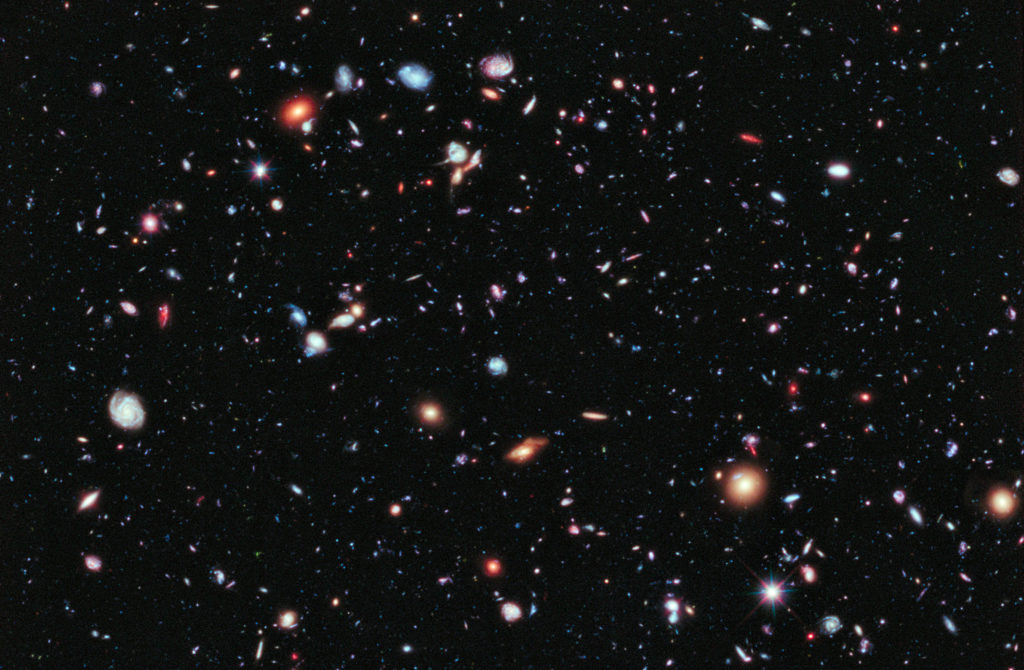All the galaxies combined, including everything within and between them, make up what we call the universe. Another way to think of the universe is as the sum total of all matter and energy in existence.
Connections—Etymology
The word universe begins with “uni,” which comes for the Latin word for “one.” So the word universe represents the idea that everything we see is part of the same whole.
I was wondering...
What is a "multiverse"?
If you follow science news, you may have heard some people talk about a “multiverse.” No one knows if it really exists, but the idea is this: Besides representing all the galaxies and everything within and between them, the universe also represents a set of laws that govern all the matter and energy in it. It’s possible that there could therefore be other “universes” with different sets of laws — and perhaps very different types of matter and energy. If so, then all the universes together would be what scientists call the multiverse.
It’s worth noting that we cannot see the entire universe, even in principle. The reason is time: Based on evidence collected through the science of astronomy, scientists have discovered that the universe is about 14 billion years old. Therefore, we can only see galaxies that are near enough for their light to have reached us in 14 billion years. We presume that there are other galaxies that are more distant, but we cannot see them because their light has not yet had enough time to reach us. Scientists define the observable universe to be the portion of the universe that we can see.
Video
Light Travel Time & Space
Light from more distant objects takes longer to reach us. Because scientists have found the universe to be about 14 billion years old, the observable universe represents the portion of the entire universe from which light has been able to reach us in 14 billion years.
The observable universe contains at least 100 billion galaxies. To understand how we know, look back at the photo that opens Chapter 1 (and is shown again, below), and remember that it shows a region of the sky that you could cover with a grain of sand held at arm’s length. By counting the galaxies in this photo and multiplying by the number of similar photos it would take to cover the entire sky, you can estimate the number of galaxies in the entire observable universe.
Group Activity

How Many Galaxies are in the Observable Universe?
- Look carefully at this Hubble Space Telescope photo that shows galaxies visible in a tiny region of the sky. Remember that relatively nearby galaxies tend to look larger, while the smaller dots are more distant galaxies. With your partner(s), discuss how you can estimate the total number of galaxies visible in the photo. Once you have a plan, make your estimate.
- Your teacher will record all the estimates on the board. Hold a brief class discussion about whether the estimates generally agree with each other. If they do, choose what you think is the best class estimate. If they don’t, discuss why they differ, and decide which estimate you think is best as a class.
- Go back to working with your partner(s). The photo shows only one tiny region of the sky, but we can assume we’d see something similar if we photographed the region right next to this photo, and then the region next to that, and so on. Overall, it would take 30 million photos like this one to make a picture showing all the galaxies in all directions in the sky. Use this fact to estimate the total number of galaxies in the observable universe.
- Compare the answers from all the groups. Do they agree? They should, so if they don’t, try to figure out why not, and then recheck your calculations until everyone agrees.
For this activity, you should ideally have students work in pairs or in groups of three. Note that this activity involves some actions on your part: In Step 2 you will need to record all the estimates and lead the discussion to get a best estimate for the class. In Step 3, students will have to do a calculation (multiplying the best estimate from Step 2 by 30 million), so they may need help depending on their level of math skills.